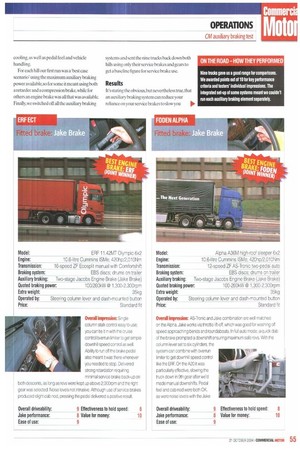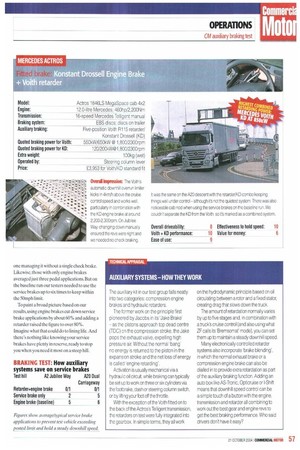CAI GO DOWNHILL
Page 56

Page 57

Page 58

Page 59

If you've noticed an error in this article please click here to report it so we can fix it.
As drivers increasingly rely on their trucks' foundation brakes, we pose the question, 'what use are auxiliary systems?'
How effective are auxiliary systems when it comes to reducing the reliance on service brakes? And which offers the best value for money? To find out, Commercial Motor issued the manufacturers a simple challenge. Give us a fully laden artic equipped with an auxiliary braking system and we'll put it to the test. We must have pressed the right button as no less than nine turned up. ready to hit the slopes.
Test route and procedure
The 1.4km Jubilee Way on the A2 is a nasty 5% gradient that takes traffic down into Dover's Eastern Docks, It has two escape bays for those who get it wrong.To make it more interesting,halfway down the 40rnph speed limit drops to 30mph— forcing you to brake whether you want to or not — and as you approach the bottom it curves around 180° to end at a roundabout.The good news is that it makes for reliably repeatable testing.
But we wanted more than one hill.The A20 into Dover from the west also features a 2.4km downhill section. Being a 50mph dual carriageway it gives an artic's brakes an even tougher workout. So using both hills we ended up with a simple circuit in and out of Dover that could be completed inside an hour.
Naturally, we wanted to see how each auxiliary system reduced the number of service brake applications we needed, and in particular how well they maintained a steady, 'stabilised' speed within the posted limit without any help from the footbrake.
However, as soon as the vehicle's speed crept above the limit each driver had to use the footbrake to cut the vehicle's speed by 5mph before letting the auxiliary system take over again. Each check braking was recorded, along with the engine revs, gear selection, noise and cooling, as well as pedal feel and vehicle handling.
For each hill our first run was a 'best case scenario' using the maximum auxiliary braking power available,so for some it meant using both a retarder and a compression brake, while for others an engine brake was all that was available. Finally, we switched off all the auxiliary braking systems and sent the nine trucks back down both hills using only their service brakes and gears to get a baseline figure for service brake use.
Results it's stating the obvious,but nevertheless true,that an auxiliary braking system can reduce your reliance on your service brakes to slow you down andthe more powerful the system, the less you need your right foot.That's exactly what we found.But the surprise was how similar the results were across our entire test group.
For example, of the four tractors using both a retarder and an engine brake, two required just one check brake to rein them in on the Jubilee Way while the other two managed to get down without any( As all trucks had to brake down to the 30mph limit we've not counted that particular application.) Next,for those trucks with just a compression engine brake, the highest service brake pedal application needed down Jubilee Way was three, while two made it down to the bottom quite happily within the posted limits with just one check brake. But on the baseline run using only service brakes, all nine artics needed between live and six applications simply to keep within the posted speed limits.
On the fasterA20 descent it was a similar story: the four retarder and engine brakeequipped wagons kept up a high, yet perfectly safe (and legal) downhill speed, with all bar one managing it without a single check brake. Likewise, those with only engine brakes averaged just three pedal applications. But on the baseline run our testers needed to use the service brakes up to six times to keep within the 50mph limit.
To paint a broad picture based on our results, using engine brakes cut down service brake applications by about 60% and adding a retarder raised the figure to over 80%. Imagine what that could do to lining life. And there's nothing like knowing your service brakes have plenty in reserve, ready to stop you when you need it most on a steep hill.


































































































































































































